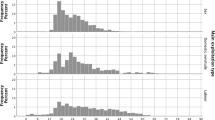Abstract
This paper examines the relationship of migration and mobility of husband and wife to sexual risk behaviors among married men living in economically marginal communities in Mumbai, India. Non-migrant men reported significantly more often than the migrant men that they had one or more sex partners other than their wives in the last year. Further, men with occupational mobility reported significantly more often than the men who were not mobile that they had one or more non-spousal sexual partners in the last 1 year. Married men living in Mumbai with wives residing in their area of origin and who reported occupational mobility had the highest sexual risk behaviors, controlling for socio-demographic characteristics and migration. Interventions aimed at prevention of HIV among men require special focus on both migrant and non-migrant men with greater occupational mobility, with particular emphasis on migrant men whose wives have remained in their pre-migration home areas.
Similar content being viewed by others
References
APSACS. (2007). HIV prevention. Andhra Pradesh: State AIDS Control Society (APSACS). http://www.apsacs.org/english/hivprevention.htm (last accessed 9 October, 2007).
Gupta, I., & Mitra, A. (1999). Knowledge of HIV/AIDS among migrants in Delhi slums. Journal of Health & Population in Developing Countries, 2(1), 26–32.
Halli, S. S., Blanchard, J., Satihal, D. G., & Moses, S. (2007). Migration and HIV transmission in rural south India: An ethnographic study. Culture, Health & Sexuality, 9(1), 85–94. doi:10.1080/13691050600963898.
Madhivanan, P., Jerajani, H., Mathur, M., Gogate, A., & Lindan, C. (2005). Sexual behavior & STIs among men at high risk for HIV infection in Mumbai, India. Poster presented at the XV International AIDS Conference, Bangkok 11–16 July 2004. ari.ucsf.edu/science/posters_2005/madhivanan.pdf (last accessed 25 July, 2007).
Mishra, A. (2004). Risk of sexually-transmitted infections among migrant men: Findings from a survey in Delhi. Asian and Pacific Migration Journal, 13, 89–105.
Poudel, K. C., Jimba, M., Okumura, J., Sharma, M., Poudel-Tandukar, K., & Wakai, S. (2004). Migration in far western Nepal: A time bomb for a future HIV/AIDS epidemic? Tropical Doctor, 34, 30–31.
Rao, A., Nag, M., Mishra, K., & Dey, A. (1994). Sexual behavior pattern of truck drivers and their helpers in relation to female sex workers. The Indian Journal of Social Work, 55(4), 603–615.
Rao, K. S., Pilli, R. D., Rao, A. S., & Chalam, P. S. (1999). Sexual lifestyle of long distance lorry drivers in India: Questionnaire survey. British Medical Journal, 318, 162–163.
Rego, A., Nadkarni, V., & Vasundhra, D. (2002). HIV/AIDS in India: A critical review of selected studies (1990–2000). The gender and reproductive health research initiative. New Delhi: CREA.
Saggurti, N., Verma, R. K., Jain, A., RamaRao, S., Kumar, K. A., Subbiah, A., et al. (2008). HIV risk behaviors among contracted and non-contracted male migrant workers in India: Potential role of labor contractors and contractual systems in HIV prevention. AIDS (London, England), 22((suppl 5)), S1–S10. doi:10.1097/01.aids.0000343771.75023.cc.
Savara, M., & Sridhar, C. R. (1994). Sexual behaviour patterns among different occupational groups in Maharashtra, India and the implications for the AIDS education. The Indian Journal of Social Work, 55, 617–632.
Schensul, S. L., Hawkes, S., Saggurti, N., Verma, R. K., Narvekar, S. S., Nastasi, B. K., et al. (2007). Sexually transmitted infections in men in Mumbai slum communities: The relationship of prevalence to risk behavior. Sexually Transmitted Diseases, 34, 444–450.
Schensul, S. L., Mekki-Berrada, A., Nastasi, B. K., Singh, R., Burleson, J. A., & Bojko, M. (2006a). Men’s extramarital sex, marital relationships and sexual risk in urban poor communities in India. Journal of Urban Health, 83, 614–624. doi:10.1007/s11524-006-9076-z.
Schensul, S. L., Nastasi, B. K., & Verma, R. K. (2006b). Community-based research in India: A case example of international and transdisciplinary collaboration. American Journal of Community Psychology, 38, 95–111. doi:10.1007/s10464-006-9066-z.
Schensul, S. L., Verma, R. K., & Nastasi, B. K. (2004). Responding to men’s sexual concerns: Research and intervention in slum communities in Mumbai, India. International Journal of Men’s Health, 3, 197–220. doi:10.3149/jmh.0303.197.
Singh, S. K., Gupta, K., Lahiri, S., & Schensul, J. (2006). Dynamics of social networking, drug abuse and risk behaviour to STD and HIV/AIDS in India: A case study of adult male migrants in Surat, India. In Arvind. Pandey (Ed.), Bio-statistical aspects of health and population. New Delhi: Hindustan Publishing Corporation.
Thappa, D. M., Manjunath, J. V., & Kartikeyan, K. (2002). Truck drivers-at increased risk of HIV infection amongst STD clinic attendees. Indian Journal of Dermatology, Venereology and Leprology, 68, 312.
Vemuri, M. D., & Bhattacharya, S. (2004). Migration pattern of Uttar Pradesh’s population. Calcutta, India: SAATHI Library.
Verma, R. K., Saggurti, N., Das, M., RamaRao, S., & Jain, A. (2007). Patterns and implications of male migration for HIV prevention strategies in Andhra Pradesh. Technical Brief from Population Council India, 1: March. Also Available at: www.popcouncil.org/pdfs/India_TechBrief.pdf (last accessed 10 August, 2007).
World Bank. (2002). Better health systems for India’s poor: Findings, analysis, and options, Human Development Network, Health, Nutrition and Population Series. Washington: World Bank.
Acknowledgments
The research on which this paper is based was funded by the National Institute of Mental Health, “Male Sexual Concerns and Prevention of HIV/STD in India” (RO1-MH64875) and a supplement, “Assessing Women’s HIV/STD Risk in Marriage in India” funded by the Office of AIDS Research of the National Institutes of Health. The authors are indebted to the field and office staff of the RISHTA project at the International Institute for Population Sciences for their hard work and commitment to the collection of quality data under difficult circumstances. We also appreciate the careful review and inputs of Dr. Pertti J. Pelto and Dr. Sarah Hawkes in earlier drafts of this paper.
Author information
Authors and Affiliations
Corresponding author
Rights and permissions
About this article
Cite this article
Saggurti, N., Schensul, S.L. & Verma, R.K. Migration, Mobility and Sexual Risk Behavior in Mumbai, India: Mobile Men with Non-Residential Wife Show Increased Risk. AIDS Behav 13, 921–927 (2009). https://doi.org/10.1007/s10461-009-9564-8
Received:
Accepted:
Published:
Issue Date:
DOI: https://doi.org/10.1007/s10461-009-9564-8




